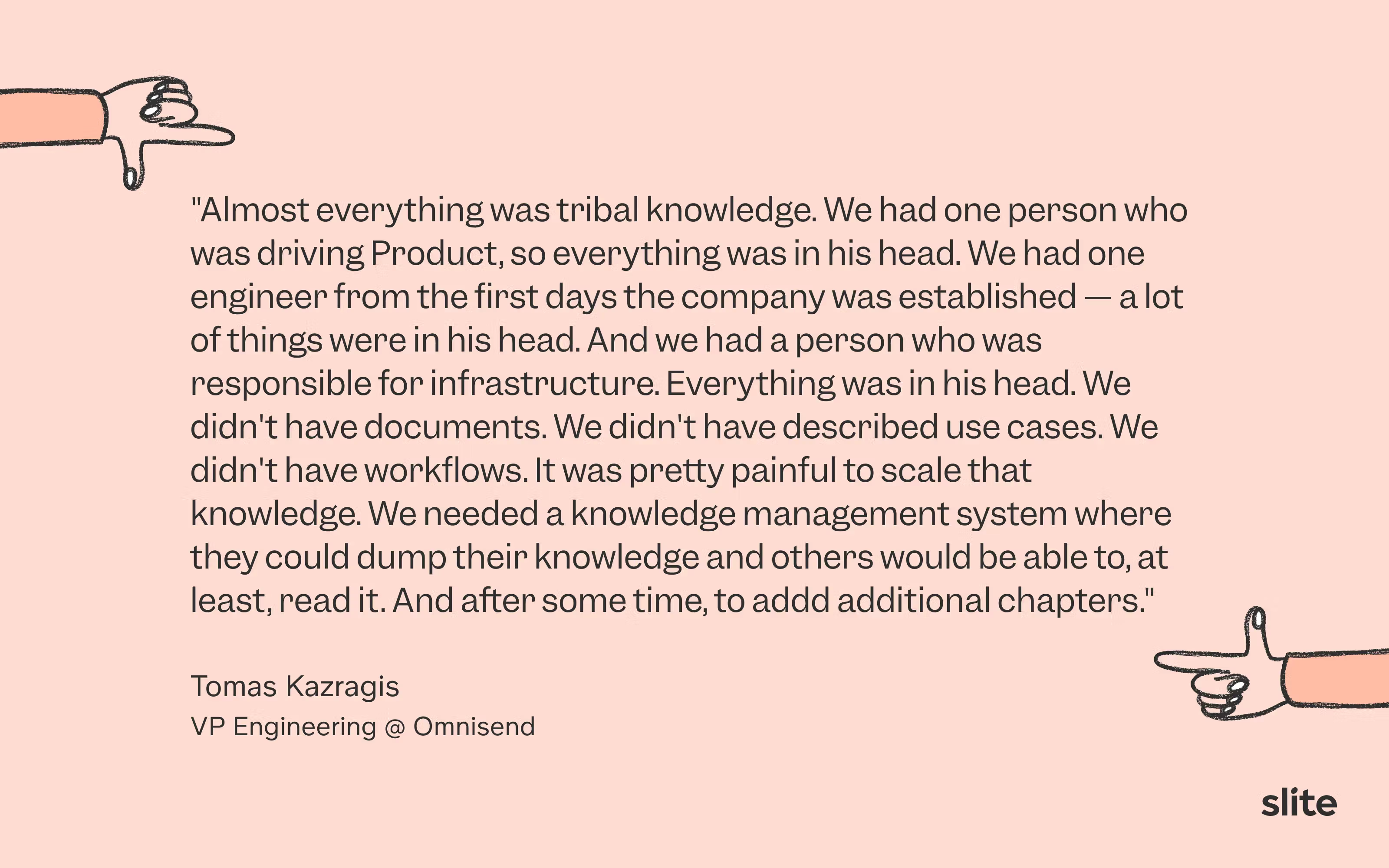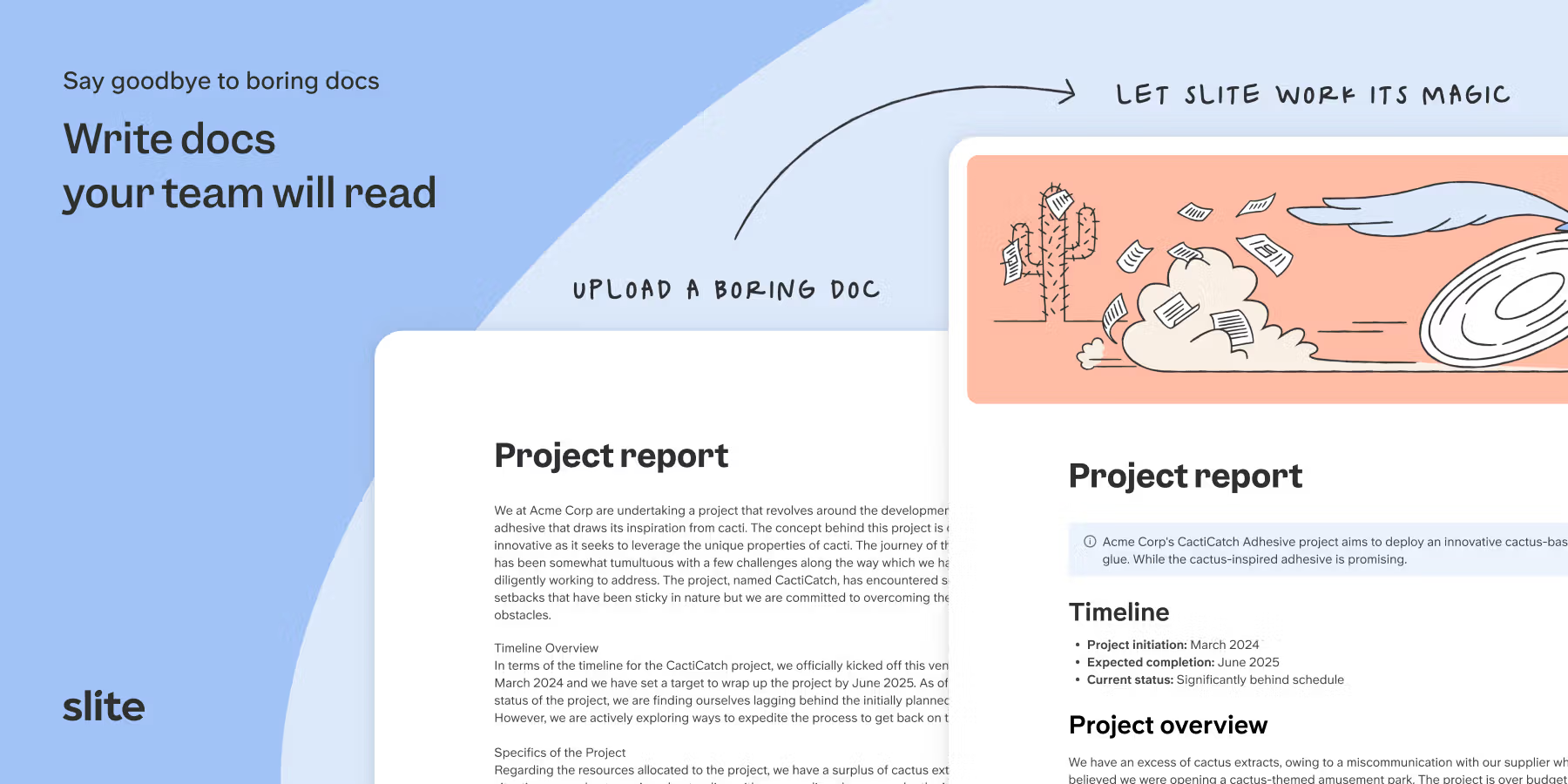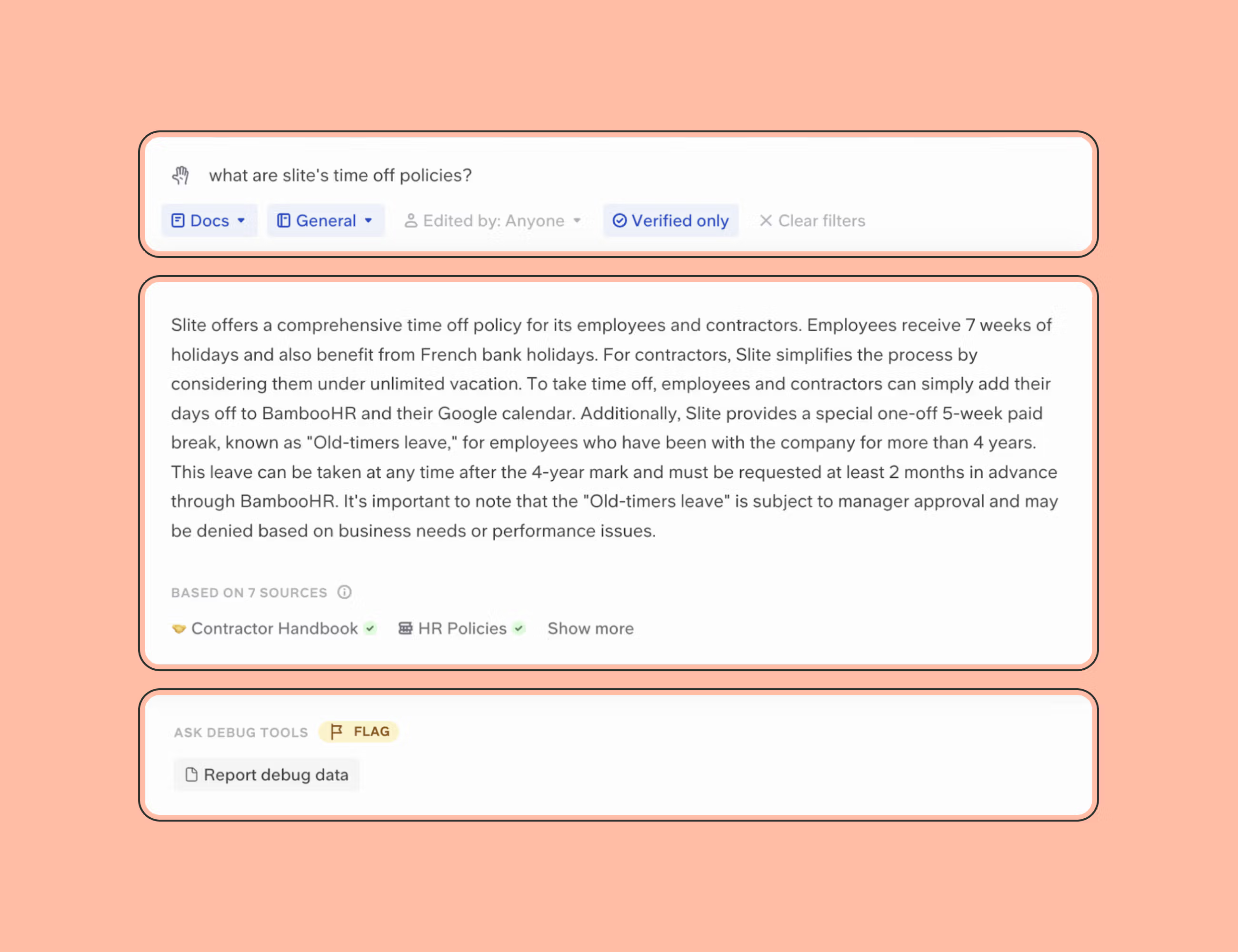Una wiki empresarial, la base de conocimiento interna de tu empresa, es esencial. Una wiki corporativa sirve como una plataforma centralizada para almacenar y compartir información empresarial dentro de una organización.
Pero seamos honestos, la mayoría de las wikis terminan siendo un páramo descuidado de información desactualizada.
¿Por qué tantas wikis empresariales no logran alcanzar su potencial?
A menudo, sufren de sobrecarga de información, mala organización y falta de participación.
En esta guía, profundizaremos en los elementos clave de una wiki empresarial exitosa y te mostraremos cómo crear una que tu equipo realmente use y ame.
Si estás buscando una forma rápida e indolora de comenzar, consulta el Generador de Wikis gratuito de Slite.
Pero si estás listo para arremangarte y construir una wiki desde cero, vamos a sumergirnos.
¿Qué es una Wiki Empresarial?
Una wiki empresarial es la Wikipedia interna de tu empresa: un repositorio centralizado de conocimiento, documentación e información relevante para tu negocio. Es una plataforma colaborativa donde los miembros del equipo pueden crear, editar y compartir documentos, asegurando que todos tengan acceso a la información más actualizada. Una wiki de empresa promueve el intercambio de conocimientos, la actualización continua y el fácil acceso a la información para todos.
A diferencia de las intranets o bases de conocimiento tradicionales, una wiki empresarial es más que una simple colección estática de documentos. Es un organismo vivo y que respira que evoluciona junto con tu empresa. Es un lugar donde los empleados pueden contribuir con su experiencia, compartir las mejores prácticas y encontrar las respuestas que necesitan para hacer su trabajo de manera efectiva.
Por qué tu Wiki Empresarial es Importante para el Conocimiento de la Empresa
Una wiki empresarial bien engrasada no es solo un lujo, sino un cambio de juego para centralizar y preservar el conocimiento de la empresa. Es como tener un sistema nervioso central para tu empresa, conectando a cada departamento, equipo e individuo con el conocimiento que necesitan para prosperar.
No Más Persecuciones Inútiles
¿Cansado de buscar entre interminables correos electrónicos e hilos de Slack para encontrar esa pieza crucial de información? Una wiki interna de la empresa lo pone todo en un solo lugar, ahorrándote tiempo y frustración.
Esto es especialmente importante si has pasado de una empresa mediana a una grande en poco tiempo. Los equipos que contratan rápidamente, casi siempre se enfrentan al problema del conocimiento tribal.
Omnisend faced it firsthand.

Todos en la Misma Página
¿Incorporación de nuevos empleados? ¿Lanzamiento de un nuevo producto? Una wiki asegura que todos tengan acceso a la información más actualizada, eliminando la confusión y la falta de comunicación tanto para los empleados existentes como para los futuros. Esta es una de las principales razones por las que OneUp Sales - a Performance Management software for Sales teams - built their wiki in Slite.
Alex siempre fue el nerd de la documentación en OneUp.

A nivel de equipo, vio de inmediato la desventaja de la falta de documentación. No había una guía de incorporación, y los nuevos empleados eran lanzados a tareas y equipos sin ningún contexto de en qué estaban trabajando o por qué.
Empodera a tu Gente y a los Futuros Empleados para que se Autoabastezcan Primero
Cuando tu fuerza laboral incluye trabajadores sin escritorio que pueden no tener direcciones de correo electrónico de la empresa o fácil acceso a unidades compartidas, o equipos distribuidos repartidos en diferentes zonas horarias, se vuelve aún más difícil para todo el equipo obtener la información que necesitan de forma rápida y eficiente. Una wiki puede proporcionar una base de conocimiento de autoservicio accesible en cualquier momento y desde cualquier lugar, lo que permite a los empleados encontrar respuestas y soluciones de forma independiente.
Esto reduce la necesidad de comunicación de ida y vuelta, lo que puede ser especialmente difícil con los equipos asíncronos. Además, asegura que todos tengan acceso a la misma información, promoviendo la consistencia y reduciendo el riesgo de errores o malentendidos.
El Liderazgo de C-Suite obtiene respuestas sin MD
Con todo el conocimiento de tu empresa al alcance de tu mano, puedes tomar decisiones informadas más rápida y confiadamente. Y esa es una necesidad seria para tu equipo de liderazgo, más que para nadie.
A Simo Lemhandez, Fundador de Folk le encanta la búsqueda con IA de Slite por la misma razón:
“Este es un desafío que siempre tenemos: encontrar el documento correcto y dónde se almacenan los datos. Aún más para los nuevos empleados que se están incorporando. ¡Es una locura cómo esta función encaja en nuestro día a día!”
Cómo Construir una Wiki Empresarial que tu Equipo Realmente Use (¡y Ame!)
Construir una wiki próspera requiere más que simplemente elegir el software de wiki adecuado. Requiere un enfoque estratégico, una planificación cuidadosa y un compromiso continuo con el mantenimiento. Aquí está tu guía paso a paso:
1 Define el Propósito y el Alcance de tu Wiki
Comienza preguntándote: “¿Por qué estamos creando una wiki?” ¿Estás buscando optimizar la incorporación, centralizar el conocimiento disperso, fomentar una mejor colaboración o todo lo anterior? Definir claramente tu propósito te ayudará a enfocar tus esfuerzos y medir el éxito en el futuro.
Una vez que tengas tu “por qué”, es hora de identificar a tu audiencia. ¿Quién usará esta wiki? ¿Cuáles son sus roles y responsabilidades? ¿Qué tipo de información están buscando? Comprender a tu audiencia te ayudará a adaptar tu contenido y estructura a sus necesidades específicas.
Finalmente, crea un esquema de alto nivel de los temas que cubrirá tu wiki. Esto podría incluir:
- Valores y cultura de la empresa
- Procedimientos operativos estándar (SOP)
- Documentación del proyecto y hojas de ruta
- Guías técnicas y solución de problemas
- Políticas de RR. HH. e información sobre beneficios
Considera los desafíos comunes que enfrentan las wikis de la empresa, como el contenido desactualizado, la mala experiencia de búsqueda y la falta de compatibilidad con dispositivos móviles, para asegurar que tu wiki siga siendo eficaz y fácil de usar
2 Elige el Software de Wiki Adecuado
No faltan plataformas wiki en el mercado, cada una con sus propias fortalezas y debilidades. Investiga y compara características, precios y facilidad de uso. Considera factores como:
- Escalabilidad: ¿Crecerá la plataforma con tu empresa?
- Búsqueda: ¿Qué tan fácil es encontrar información?
- Colaboración: ¿Admite la edición y los comentarios en tiempo real?
- Integraciones: ¿Puede conectarse con las herramientas que tu equipo ya usa?
Si tu enfoque principal es construir una base de conocimiento, Slite es un fuerte contendiente. Su interfaz fácil de usar, su búsqueda robusta y sus funciones impulsadas por IA facilitan la creación y el mantenimiento de una wiki eficaz. Para aquellos que buscan crear un sitio wiki empresarial, SharePoint ofrece un proceso sencillo y una guía completa para comenzar. La mayoría de las plataformas ofrecen pruebas gratuitas o demostraciones, así que pruébalas para ver cuál se adapta mejor a tu equipo.
3 Organiza tu Wiki
Una wiki bien organizada es fácil de navegar y usar, lo que asegura que tu equipo pueda encontrar rápidamente la información que necesita.
- Crea una Jerarquía Clara: Estructura tu wiki en categorías principales (por ejemplo, RR. HH., Ingeniería, Marketing) y luego divídelas en subcategorías (por ejemplo, Incorporación, Beneficios, Políticas).
- Usa Etiquetas y Metadatos: Las etiquetas y los metadatos (como el autor, la fecha o el departamento) pueden facilitar el filtrado y la búsqueda de contenido específico.
- Implementa una Navegación Clara: Usa menús, rutas de navegación y una barra de búsqueda para ayudar a los usuarios a orientarse. Incorpora enlaces internos para guiar a los lectores a páginas relevantes y definir la estructura de la wiki. Una tabla de contenido simple o una guía de “primeros pasos” puede ser útil para los nuevos usuarios.
- Administra los Permisos: No toda la información debe ser accesible para todos. Establece permisos claros para controlar quién puede ver y editar páginas específicas.
4 Cree contenido atractivo
El contenido es el corazón y el alma de su página wiki. ¡Hágalo brillar!
Al crear contenido, es esencial que sea conciso.
Utilice viñetas, listas numeradas y párrafos cortos para que su contenido sea fácil de hojear. Evite la jerga y los términos técnicos que su público tal vez no entienda. En su lugar, utilice la voz activa y verbos fuertes para atraer a sus lectores.
Además, revise cuidadosamente su trabajo para detectar errores de gramática y ortografía. Para asegurarse de que su contenido siga siendo preciso y relevante, actualícelo periódicamente.
En cuanto al lenguaje, priorice la claridad y la capacidad de acción. Utilice un lenguaje fácil de entender y evite la jerga o los términos técnicos. Si utiliza términos desconocidos, defínalos. Proporcione instrucciones claras y los siguientes pasos para que su público sepa exactamente qué hacer.
Y si está utilizando Slite, puede hacer todo lo anterior
- Seleccionando el contenido en el documento de Slite
- Haciendo clic en Mejora rápida
Y para editar documentos sobre la marcha, utilice el Formateador mágico de documentos gratuito de Slite. Automáticamente:
- Divide el contenido en párrafos más pequeños
- Pone en negrita, cursiva y subraya las frases importantes
- Organiza tu documento en subtítulos para facilitar la navegación

Para dividir bloques largos, agregue imágenes, videos, gráficos o diagramas. Estos elementos visuales pueden mejorar el atractivo de su contenido y ayudar a transmitir su mensaje. Al elegir elementos visuales, asegúrese de que sean relevantes para su contenido y de alta calidad.
Por último, el uso de plantillas puede ayudar a mantener la coherencia y la facilidad de uso de los documentos comunes, como las notas de las reuniones, las propuestas de proyectos y las listas de verificación de incorporación. Las plantillas garantizan que todos sigan un formato estándar y hacen que sus documentos sean más accesibles y fáciles de usar. Además, las plantillas pueden ser herramientas que ahorran tiempo al crear nuevos documentos.
5 Fomente la colaboración
Una wiki no es solo un recurso de arriba hacia abajo. Debe ser un documento vivo y dinámico que evolucione con su empresa.
- Facilite que todos contribuyan con sus conocimientos proporcionando instrucciones y directrices claras tanto para los empleados actuales como para los futuros.
- Reconozca a los miembros del equipo que crean contenido útil.
- Fomente una cultura de intercambio en la que todos se sientan capacitados para contribuir.
6 Mantenga y actualice su wiki
Una wiki nunca está realmente "terminada". Es un proyecto continuo que requiere atención y cuidado regulares.
- Asigne propietarios de contenido: Asegúrese de que cada sección de su wiki tenga un propietario designado responsable de mantener la información precisa y actualizada.
- Programe revisiones periódicas: Establezca un programa para revisar y actualizar el contenido, especialmente para la información urgente, como las políticas o los procedimientos dentro de las páginas wiki.
- Recopile comentarios: Anime a su equipo a proporcionar comentarios sobre la usabilidad y el contenido de la wiki. Utilice estos comentarios para identificar áreas de mejora.
Con los pasos anteriores, tendrá su primera wiki en su lugar, ¡felicidades!
Pero construir una wiki, lamentablemente, es la parte fácil. Casi todas las empresas tienen alguna forma de wiki. El desafío es que, después de la emoción inicial de una nueva wiki, rápidamente se vuelve desordenada, inutilizable y, en consecuencia, olvidada por el equipo.
Por lo tanto, su wiki empresarial puede fallar incluso después de construir la perfecta, porque les sucede a los equipos todo el tiempo. Veamos por qué.
5 razones por las que las wikis empresariales fallan
Estas son las 5 razones más comunes por las que las wikis fallan y cómo puede evitar estos errores:
- Sobrecarga de información: Demasiada información, a menudo mal organizada, dificulta que los empleados encuentren lo que necesitan. Evite esto creando una estructura clara, utilizando categorías y etiquetas, y archivando o eliminando regularmente el contenido obsoleto.
- Contenido irrelevante u obsoleto: Si su wiki no se actualiza regularmente, rápidamente se vuelve irrelevante. Asegúrese de que su wiki sea un documento vivo que refleje el estado actual de su empresa. Asigne propietarios de contenido y establezca un proceso de revisión regular para mantener la información actualizada.
- Falta de participación: Una wiki es tan buena como sus colaboradores. Fomente la participación facilitando a los empleados la adición y edición de contenido. Considere la gamificación o los incentivos para motivar las contribuciones.
- Mala funcionalidad de búsqueda: Si los usuarios no pueden encontrar lo que buscan, rápidamente renunciarán a su wiki. Invierta en una plataforma con sólidas capacidades de búsqueda y considere la posibilidad de utilizar la búsqueda impulsada por IA para mostrar contenido relevante.
- Falta de promoción: Si su equipo no conoce la wiki o no entiende su valor, no la utilizará. Asegúrese de promocionar su wiki regularmente y destacar sus beneficios para su equipo.
Organización de su wiki empresarial
Aquí le mostramos cómo crear una estructura que haga que la biblioteca de páginas de su wiki sea un placer para navegar:
1. Combine lo mejor de ambos mundos
No se limite a una sola estructura organizativa. Adopte el poder de la organización jerárquica y basada en el contenido. Esto le permite crear un marco que sea lógico y flexible.
- Organización jerárquica: Piense en esto como la columna vertebral de su wiki. Proporciona una estructura de arriba hacia abajo con categorías principales y subcategorías. Por ejemplo, podría tener una categoría principal para "RR. HH." con subcategorías para "Incorporación", "Beneficios" y "Políticas". Utilice la biblioteca de páginas del sitio para crear vistas y filtros que ayuden a administrar y organizar estas categorías de manera eficaz.
- Organización basada en el contenido: Este enfoque conecta piezas de información relacionadas independientemente de su posición jerárquica. Por ejemplo, podría vincular un documento sobre el lanzamiento de un nuevo producto a materiales de marketing relevantes, especificaciones técnicas y comentarios de los clientes.
2. Utilice categorías, etiquetas y metadatos
Las categorías y las etiquetas son como señales que guían a los usuarios a la información correcta. Utilícelas libremente para clasificar su contenido y facilitar la búsqueda y el filtrado. Los metadatos, como el autor, la fecha y el departamento, pueden proporcionar contexto adicional y ayudar a los usuarios a encontrar la información más relevante.
3. Cree una navegación y un enlace claros
Asegúrese de que su wiki tenga un menú de navegación fácil de usar que permita a los usuarios acceder rápidamente a diferentes secciones. Utilice las rutas de navegación para mostrar a los usuarios dónde se encuentran en la jerarquía y cree enlaces internos para conectar documentos relacionados.
4. Administre los permisos y los controles de acceso
No toda la información de su wiki debe ser accesible para todos. Implemente controles de acceso para asegurarse de que la información confidencial solo sea visible para los usuarios autorizados. Esto protegerá los datos confidenciales y garantizará que los empleados solo vean la información que sea relevante para sus funciones.
Slite: La clave para una wiki empresarial exitosa
Slite está diseñado desde cero para abordar los puntos débiles que aquejan a las wikis tradicionales.
Así es como puede transformar su gestión del conocimiento:
- Organización intuitiva: La estructura jerárquica limpia y el sistema de etiquetado intuitivo de Slite facilitan la organización de la información de una manera que tenga sentido para su equipo. No más desplazamientos interminables ni búsquedas en carpetas para encontrar lo que necesita.
- Búsqueda y descubrimiento potentes: El sólido motor de búsqueda de Slite y las sugerencias impulsadas por IA ayudan a los usuarios a encontrar rápidamente la información que buscan. Diga adiós a las búsquedas frustrantes y hola a las respuestas instantáneas.

- Colaboración perfecta: Las funciones de edición, comentarios y @menciones en tiempo real de Slite fomentan un entorno de colaboración donde todos pueden contribuir y compartir sus conocimientos.
- Impulsores de la participación: La incrustación de medios enriquecidos, las plantillas y las opciones de formato personalizables de Slite hacen que la creación y el consumo de contenido sean agradables. Fomente la participación con reacciones y discusiones para mantener su wiki animada e interactiva.
- Integración con su flujo de trabajo: Slite se integra a la perfección con herramientas populares como Slack, G Suite y GitHub, lo que lleva su base de conocimientos directamente a su flujo de trabajo existente.
Conclusión
Una wiki empresarial bien elaborada es más que una simple colección de documentos: es un centro de conocimiento dinámico que permite a su equipo hacer su mejor trabajo. Siguiendo las estrategias descritas en esta guía y aprovechando una plataforma como Slite, puede crear una wiki que no solo sea útil, sino también agradable de usar.

